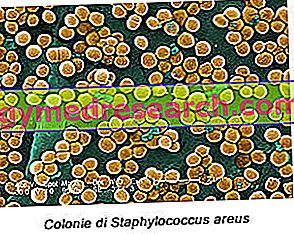The bacterium
Staphylococcus aureus is a gram-positive, spherical, asporiginal bacterium, which is arranged in colonies giving rise to chain-shaped bacterial clusters, sometimes similar to a bunch of grapes. Staphylococcus aureus is considered a rather common saprophyte: it mainly colonizes the nasopharyngeal mucous membranes and can also be isolated at the level of the skin and its glands, and more rarely in the vagina, intestine and perineum.

Diseases caused by Staphylococcus aureus
Staphylococcus aureus is the most common etiological agent of skin and soft tissue infections; it concerns in particular pyogenic infections (therefore forming pus) which appear as pimples and abscesses. Other pyogenic affections related to Staphylococcus aureus include some forms of gastroenteritis (food poisoning), but also more serious diseases, such as osteomyelitis, septic arthritis, bursitis, toxic shock syndrome, toxic epidermal necrolysis, pneumonia, meningitis and endocarditis. Staphylococcus aureus is also a common cause of nosocomial infections, and can affect patients undergoing surgery or invasive maneuvers, complicating healing. Some strains of Staphylococcus aureus produce toxins responsible for two typical clinical syndromes: a) toxic shock syndrome, characterized by fever, vomiting, diarrhea, confusional state and skin rash, multi-organ failure and skin desquamation; b) the syndrome of the skin (pseudo) burned, which mainly affects children during early childhood characterized by the detachment of large areas of the epidermis (not surprisingly, the toxin involved is known as exfoliatin).
Human-to-human transmission takes place via airborne via the dispersion of infected droplets emitted through coughing or sneezing, but also by direct contact, for example through the hands of an infected individual.
Food-borne cough-infections from Staphylococcus areus (staphylenterototoxicosis) - characterized by the appearance, within a few hours of consumption of food contaminated by enterotoxin-producing strains, of uncontrollable vomiting, sometimes associated with chills, mild thermal rise and diarrhea, - usually occur for the consumption of contaminated foods, for example handled by people with staphylococcal dermatological infections. The food most at risk remains raw milk from cows with mastitic pathology, while pasteurization and other heat treatments destroy the microorganism, but not its toxins. The boiling of freshly milked or stored in the refrigerator are a valid aid in controlling bacterial multiplication, since Staphylococcus aureus does not grow at temperatures below 5-6 ° C and produces toxins only at temperatures above 12-13 ° C . Staphylococcus aureus is able to develop even in the presence of high salt concentrations (7.5% NaCl) and low humidity, conditions capable of inhibiting the growth of most bacterial species; consequently, the micro-organism can also develop in foods with high concentrations of salt, such as hams and processed meats, as well as in dried products. In addition to milk and its derivatives, foods with a high protein content, such as meat, fish and eggs, represent the foodstuffs most at risk of contamination from Staphylococcus aureus .
Treatment and resistance to antibiotics
The indiscriminate use of antibiotics has led, as often happens, to the development of resistant methicillin strains, therefore insensitive to the action of penicillins and cephalosporins, and in more recent times of other strains with multiple resistance, developed also against vancomycin, one of the few drugs, together with teicoplanin, still capable of eradicating the infections of this bacterium. Of the approximately two billion human beings colonized by Staphylococcus aureus, it was estimated that in 2006 the carriers of MRSA strains were between 2 and 53 million, but other studies attribute a greater scope to the phenomenon.
It follows the importance of a correct diagnosis, which foresees the isolation of the bacterium - through direct culture and microscopic examinations or through modern genetic techniques of DNA amplification - followed by antibiotic sensitivity test (antibiogram). Since the hands represent an important means by which Staphylococcus aureus infection can be transmitted, it is important that the health personnel or those in contact with affected persons provide for thorough hand washing with disinfectant soap or base preparations. of alcohol, after coming into contact with colonized patients. Among the new generation antibiotics active against Staphylococcus aureus we report quinupristin / dalfopristin, a streptogramin, and linezolid, belonging to the oxazolidinone class.



